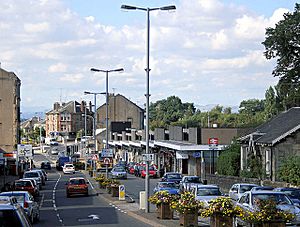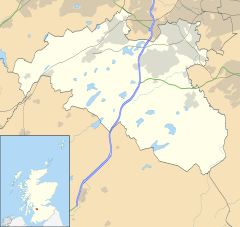Clarkston, East Renfrewshire facts for kids
Quick facts for kids Clarkston
|
|
|---|---|
 Busby Road, Clarkston's main shopping street |
|
| Population | 9,800 (2020) |
| OS grid reference | NS574576 |
| • Edinburgh | 50 mi (80 km) ENE |
| • London | 343 mi (552 km) SSE |
| Council area | |
| Lieutenancy area | |
| Country | Scotland |
| Sovereign state | United Kingdom |
| Post town | GLASGOW |
| Postcode district | G76 |
| Dialling code | 0141 |
| Police | Strathclyde |
| Fire | Strathclyde |
| Ambulance | Scottish |
| EU Parliament | Scotland |
| UK Parliament |
|
| Scottish Parliament |
|
Clarkston (also known as Scots: Clairkstoun or Scottish Gaelic: Baile Chlarc) is a town in East Renfrewshire, Scotland. It's a "dormitory town," meaning many people live here and travel to work in bigger cities. Clarkston has about 10,000 people. It is located near Glasgow and other towns like Busby and Giffnock.
On October 21, 1971, a sad event happened in Clarkston. The main shopping building was damaged in an explosion. This event caused 22 deaths and injured about 100 people. A special plaque is now there to remember what happened. The building was later rebuilt.
Greenbank Garden, a beautiful garden owned by the National Trust for Scotland, is just outside Clarkston. It is a great place to visit.
Contents
History of Clarkston
Clarkston started to grow in the 1790s. A new road was built from Paisley to East Kilbride. Where this new road crossed an older road, a toll point was set up. A man named John Clark built a house near this toll. That is how the area got its name, 'Clarkston'.
At first, Clarkston grew slowly. People living there often worked in mills in nearby Netherlee. In the early 1900s, the town began to grow much faster. This was because of the new Clarkston railway station, which opened in 1866. Also, the Glasgow tram network reached Clarkston in 1921.
Many new houses were built in Clarkston during the 20th century. Areas like Stamperland, Carolside, and Williamwood were developed. In the 1970s, more houses were built in High Carolside. The money from this helped restore Greenbank House. The Fairfield estate was built in the 1990s. More recently, new flats and townhouses have been built in the 21st century.
Clarkston is also home to two golf clubs. The Cathcart Castle Golf Club opened in 1895. It moved to Clarkston in 1924. The Williamwood Golf Club started in 1906. The land for this club was once part of Drumby Farm.
How Clarkston is Governed
Clarkston is part of East Renfrewshire. This is one of Scotland's 32 local government areas. The East Renfrewshire Council manages local services. These include things like schools and roads. Clarkston is grouped with Busby and Netherlee for local elections. Together, they elect three councillors to the council.
Scotland has its own parliament, called the Scottish Parliament. It makes decisions about things like education and health. The Parliament of the United Kingdom in London handles bigger issues. Clarkston elects one person to the UK Parliament. This person is called a Member of Parliament (MP). The current MP for East Renfrewshire is Kirsten Oswald. For the Scottish Parliament, Clarkston is part of the Eastwood area. Its representative is Jackson Carlaw.
Clarkston's Location and Climate
Clarkston is located in Scotland's Central Lowlands. It is about 5.5 miles (8.9 km) south of Glasgow. Clarkston is very close to Glasgow. It is part of Greater Glasgow, which is a large group of towns and cities.
Clarkston has a temperate maritime climate. This means it has cool summers and mild winters. It rains regularly throughout the year, but usually not too heavily.
Clarkston uses the G76 postcode. This postcode also covers nearby places like Busby and Eaglesham.
People of Clarkston
| Clarkston | East Renfrewshire | Scotland | |
|---|---|---|---|
| Total population | 14,944 | 89,311 | 5,062,011 |
| Foreign born | 2.9% | 3.8% | 3.8% |
| Over 75 years old | 7.12% | 6.9% | 7.1% |
| Unemployed | 1.9% | 2.5% | 3.9% |
In 2001, Clarkston had a population of 19,944 people. This was about 21% of all the people in East Renfrewshire. The average age of people in Clarkston was around 38 for males and 41 for females. Most people (97.1%) living in Clarkston were born in the United Kingdom. About 91.8% were born in Scotland.
Many adults in Clarkston (44%) work full-time. About 13.1% work part-time. Some people are self-employed (7.2%). Clarkston has a lower unemployment rate than Scotland as a whole.
Fun Places to Visit
Greenbank Garden is a popular spot in Clarkston. It has an old house from the 1700s and beautiful gardens. It is a Category A listed building, which means it is very important.
For sports, there is the Clarkston Bowling and Tennis Club. Overlee Playing Fields, also known as Overlee Park, is a large park. It has sports pitches, a basketball court, and a big playground. Clarkston also has other parks like Library Hill Park and Tinkers Park. Don't forget the two golf courses: Williamwood Golf Club and Cathcart Castle Golf Club.
Getting Around Clarkston
Clarkston has good road connections to Glasgow and other towns. The A77 road goes through nearby Giffnock. The A727 road passes right through Clarkston's town centre. The M77 motorway is also close by, making it easy to travel further.
Clarkston has two train stations, both run by ScotRail:
- Clarkston railway station opened in 1866. Trains from here go to Glasgow Central.
- Williamwood railway station opened in 1929. It also has trains going to Glasgow Central.
The closest airport is Glasgow Airport. It is about 8.1 miles (13 km) away. Clarkston also has many bus routes. Buses connect the town to Glasgow city centre and other nearby areas.
Famous People from Clarkston
Many interesting people have lived in Clarkston.
- Alistair MacLean was a famous novelist.
- Sir William Kerr Fraser was a leader at Glasgow University.
- Harry Benson is a well-known international photographer.
- Judy Murray is famous in the world of tennis.
Musicians from Clarkston include:
- Michael Oakley, a music producer.
- Brian "Robbo" Robertson from the bands Thin Lizzy and Motörhead.
- Stuart Murdoch from the band Belle and Sebastian.
Churches in Clarkston
Clarkston has six churches:
- Greenbank Parish Church
- St Joseph's RC Church
- Stamperland Parish Church
- Williamwood Parish Church
- St Aidan's Episcopal Church
- Clarkston Baptist Church
Greenbank Parish Church opened in 1884. It was named after the nearby Greenbank Estate. A clock was put in the church tower to remember soldiers who died in World War I. The oldest part of the church is a Category B listed building.
St Joseph's Church was first built in 1880. It was rebuilt in 1971. St Joseph's Primary School is named after this church.
Stamperland Church was founded in 1939. It joined with Netherlee Church in 2020. However, the Stamperland Church building closed in 2022.
Williamwood Parish Church was built in 1937. It has a short bell tower and is made of red brick. It was updated in the 1990s.
St Aidan's Episcopal Church started in 1923. Its church building opened in 1925.
Clarkston Baptist Church was built in the 1970s. It is located on Arthur Street.
Public Services
Many important services in Clarkston are provided by public groups. Scottish Water provides water. Scottish Power supplies electricity. Healthcare is managed by NHS Greater Glasgow and Clyde. The Scottish Fire and Rescue Service has a fire station in Clarkston.
Police Scotland provides policing for the town. The Strathclyde Partnership for Transport helps with local bus services and train tickets. Transport Scotland looks after the local train network.
See also
 In Spanish: Clarkston (East Renfrewshire) para niños
In Spanish: Clarkston (East Renfrewshire) para niños



